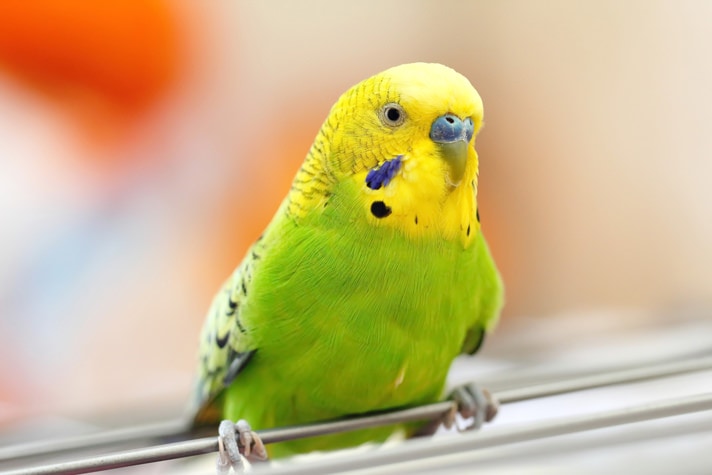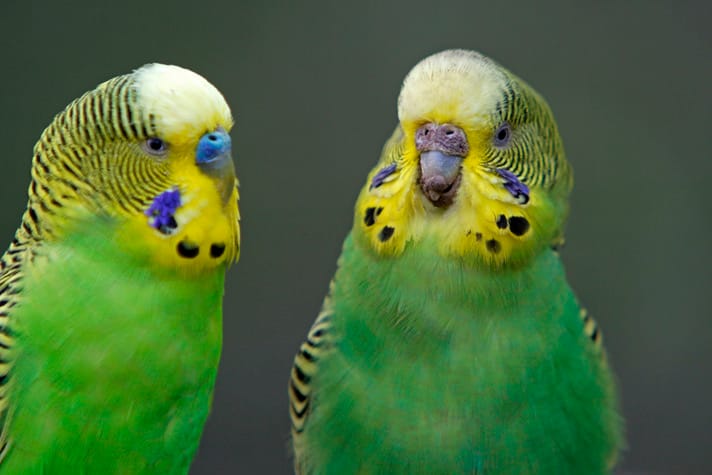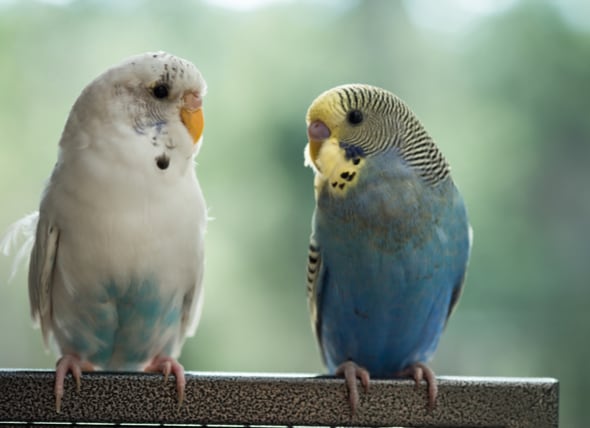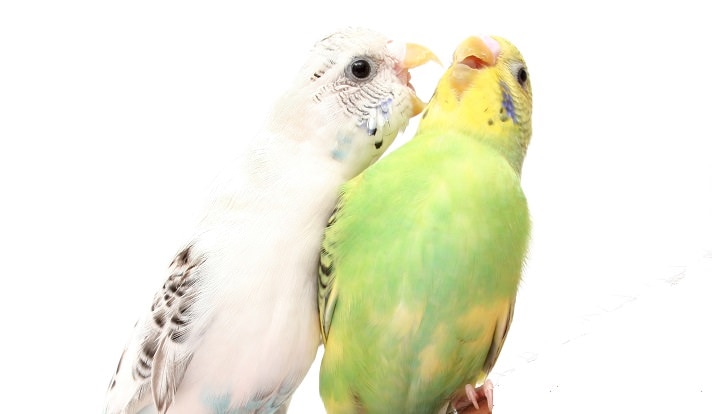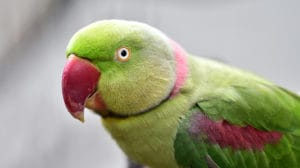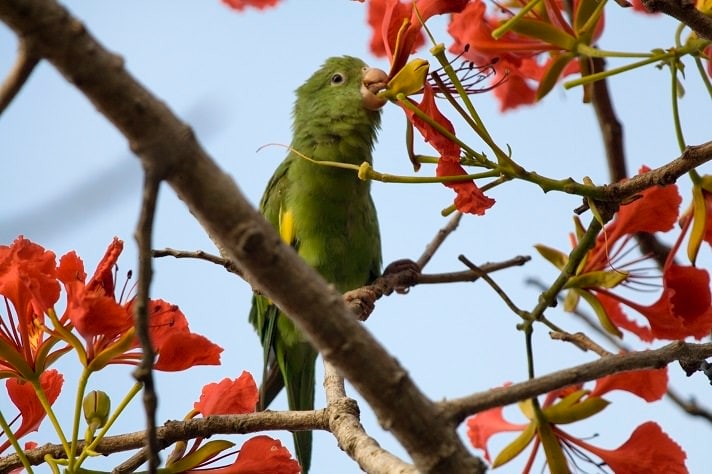Is your budgie’s beak too long? How can you tell if he is underweight? Do you have to clean his cage every day? Here are 10 budgie health questions and answers that will help you better understand your pet parakeet and keep him happy and healthy.
1. What are the common ailments for pet budgies/parakeets?
Pet budgies or parakeets may suffer from chronic, low-grade bacterial infections, especially if they are offered water from a water bowl. Fresh, clean water easily can become contaminated with droppings or food particles. If your budgie has excess bacteria in its oral cavity, every time it drinks from the bowl your pet budgie will put bacteria back into the water. Avoid this by offering your budgie water from a water bottle. Budgies are so smart, they easily figure out how to use a water bottle.
Budgies consuming a primarily seed-based diet may suffer from nutritional imbalances. If they do not eat enough plants or pellets containing beta-carotene or Vitamin A, they may develop a yeast infection, commonly from Candida sp. This may look like white plaques in the oral cavity (usually visualized by the use of a focused light source and magnification) or excessive mucus. Another common nutritional problem is obesity. Over time, an obese budgie may end up with liver problems due to excessive fat deposits in the budgie’s liver.
Overgrown beak and toenails can signify liver disease, although in many cases this can also result from the nails and beak not wearing down normally.
Regurgitation may be a sign of a crop infection, but many happy pet budgies regurgitate to their favorite toy or person and this is not a sign of any infection.
Parasites, such as Giardia, and roundworms may occur in budgies. Mites (other than Knemidokoptes) are not usually found in pet budgies, so mite protectors are unnecessary. They are also bad for pet birds, as they contain a compound that is toxic if inhaled.
Budgies, like almost all birds, can become infected by the primitive bacterium, Chlamydophila. (More on that later.)
2. My pet budgie’s/parakeet’s nares and cere are crusty. What does that mean?
The most common reason for this condition is a mite called Knemidokoptes. This usually appears as a fuzzy or crusty overgrowth of the tissue of the cere (the band of tissue over the beak), around the nares, around the skin of the eyes, around the vent or on the legs.
Your avian veterinarian can easily diagnose this condition and prescribe a course of treatment. This condition is usually found in young birds, but may also occur in older birds, as well. It may have a genetic component or may also be found in immunocompromised birds or ones suffering from another condition affecting the immune system. All birds in a cage should be treated if one is diagnosed with this mite, although it is not usually considered contagious.
While this organism isn’t life-threatening, it should always be treated after diagnosis. If not, over time, it can result in permanent deformity of the beak or toenails.
3. My pet budgie’s/parakeet’s feathers are really bright. Is this a good or bad thing?
A healthy bird should have brightly colored feathers that are not frayed, broken or bent. When birds preen, they run their long feathers through the beak to re-zip the barbs and barbules. Budgies have an uropygial gland that provides oils that help keep the feathers shiny, waterproof and supple. If the uropygial gland is not working properly due to hypovitaminosis A, feathers can end up appearing ratty or dusty.
Rarely, liver disease can cause yellow or white feathers to turn bright yellow. This can be diagnosed by appropriate diagnostic tests by your avian veterinarian.
4. My pet budgie’s cere has turned a different color. What does this mean?
The cere is the fleshy band of tissue containing the nares. Young budgies of all colors start out with a pale bluish or light tan cere, depending on the budgie’s feather color. As they reach sexual maturity, the cere color will usually change. Males of most colors will turn a vibrant blue, and females will change to tan. It can be hard to determine the sex of an adult albino, lutino or dilute-pastel-colored budgie, although many females will have a tan cere.
Sometimes, a male budgie will have a color change of the cere from blue to tan. This usually occurs because the budgie has a tumor of the testicle that is producing female hormones, resulting in the cere color change.
Females with a tan cere may develop brown hypertrophy of the cere, a thickening of cere tissue. This occurs from hormonal activity and is not dangerous nor does it need to be removed. Normally, the flaking hypertrophied tissue sloughs off over time and only becomes of concern if the tissue occludes (closes off) the openings to the nares.
5. My pet budgie eats his poop. Is that normal?
This is called coprophagy and is not normal. Keep your budgie in a cage with a grate on the bottom that allows the droppings to fall through, making them unobtainable to your pet bird. You can spray the grate with a non-stick cooking spray to help the droppings slip through more easily.
6. If I don’t clean my pet budgie’s water bowl every day or the cage every week, is he at risk?
If you provide water via a water bottle and not a bowl, sanitation becomes much less of an issue, as it is difficult to contaminate water in a bottle. Water should still be changed periodically as nobody, including our pet birds, likes the taste of stale water.
You should still offer your budgie an appropriate-sized bowl of water for bathing purposes periodically, however.
If your pet budgie’s cage has a grate in the bottom to collect debris below, you must clean it regularly. Many owners change the paper in the cage bottom daily, but certainly it must be cleaned regularly to prevent organisms from setting up housekeeping and potentially infecting your bird with fungal spores or bacterial organisms. In addition to changing the cage paper in the bottom, from time to time the entire cage should be taken apart and thoroughly cleaned and disinfected, as droppings and bits of parrot bird food can become adhered to the perches, toys, food bowls or cage bars. The most dangerous material comes from wet cage papers or moldy food that has fallen through the grate.
7. My pet budgie’s beak seems really long. Should I be concerned?
Beaks grow at a consistent rate, and some birds are better than others at naturally wearing down the beak as it grows. Some birds play, using their beak as a third foot, and others will chew through wooden toys, which effectively wears down normal beak growth.
Some birds with liver disease will show an overgrowth of the beak and nails. Blood tests can show if this is the problem or if this is simply a matter of a bird not wearing down the beak as it grows.
Some birds may have a deformity of the beak (either congenital or acquired) that causes it to grow irregularly, often showing one side that grows longer than the other. This will require corrective grinding and filing by an avian veterinarian. Also, a budgie with Knemidokoptes mites may also develop an overgrown or misshapen beak that will also require veterinary assistance. When in doubt, check with your avian veterinarian.
8. How can I tell if my pet budgie is at the right weight?
I always recommend that you purchase a good quality gram scale and get into the habit of weighing your bird on a regular basis. Weight loss or gain should be brought to the attention of your avian veterinarian.
It is difficult to give you the average weight for a pet budgie, as some are smaller birds, and others are longer and taller in stature, and those birds will naturally weigh more than smaller budgies. And English budgies are generally larger birds, and therefore will weigh significantly more than their American counterparts.
One way to determine if your pet budgie is of a good weight is by gently palpating the pectoral muscles on either side of the keel bone. You should feel a good layer of muscle that meets the keel at the midline (middle of the breast area). The muscle and underlying tissue should lie flat against the keel bone and should not bulge out on either side. If it bulges, your bird may be overweight. Concurrently, the muscle on either side of the keel should not cause the keel bone to protrude sharply, as that is a sign that a bird is too thin. Ask your avian veterinarian to help you determine if your budgie is of the correct weight. As an average, I think that a good budgie weight should be between 25 and 35 grams, depending on the body conformation.
9. My pet budgie is laying lots of eggs. What do I do?
Female budgies are determinate layers, meaning that a hen will usually lay a predetermined number of eggs per clutch. If you take her eggs away from her, however, she may begin another cycle. She will attempt to replace the eggs that, according to her, a predator removed from her nest. For this reason, it is safest and best to leave her eggs in with her, allowing her to attempt to incubate her eggs. Fertile budgie eggs will usually hatch after 18 days of incubation, and towards the end of this period, she will become bored and nature will tell her to abandon her eggs. Once this occurs, you can safely remove the clutch of eggs and she will again become your happy pet budgie.
Some hens seem more determined than others to become mothers, even if they don’t have mates. Handle these budgie hens in a way that doesn’t seem as if their human “mates” are attempting to court them! Do not spend too much time cuddling with a hen; you can also attempt to manipulate lighting, as most budgies will be influenced by increasing daylight hours. Try decreasing daylight to approximately eight hours per day, as this may shut off a female’s hormones. If your hen has an area where she prefers to nest, remove that nest site or rearrange the cage after the latest clutch has been abandoned to discourage her from laying again.
You can consult with your avian veterinarian about hormone injections to stop a hen from laying eggs. A hen should not lay too many eggs or she may become dangerously calcium depleted and prone to fractured bones, seizures or even death.
10. Should I have my budgie’s wing feathers trimmed?
There are pros and cons to grounding a pet bird, to prevent flight. A bird with trimmed wing feathers is easier to tame. And some birds that have regrown their primary feathers often develop an attitude, becoming more independent and aloof, often choosing to fly away rather than be put back in a cage, for example.
A flighted bird is at great risk for inadvertently escaping out of an open door or window. A bird can be injured flying into a window or mirror, or if closed in an open door (from a bird perching on the top of an open door).
Wing-feather trimming is as painless as getting a haircut. Several methods of trimming flight feathers exist to allow a bird to gently glide to the ground and not fall like a ton of bricks. I recommend trimming flight feathers for pet birds, unless specific special circumstances indicate that a bird needs the ability to fly (to escape predators or for weight loss, for example).
By: Margaret A. Wissman, DVM
Featured Image: lisaaMC/iStock/Thinkstock
Share:
